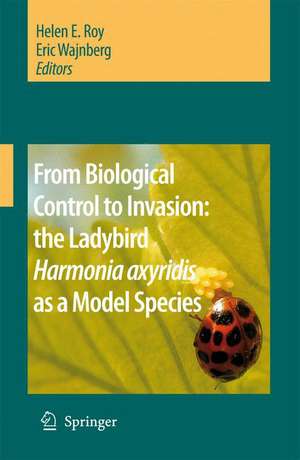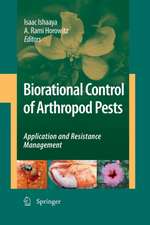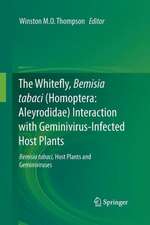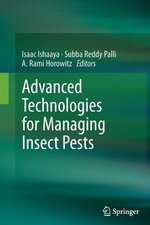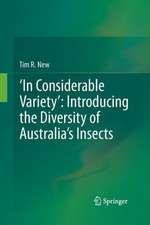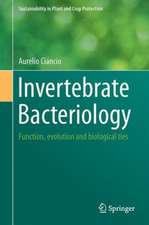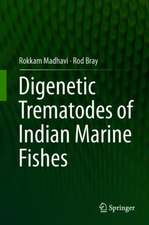From Biological Control to Invasion: the Ladybird Harmonia axyridis as a Model Species
Editat de Helen E. Roy, Eric Wajnbergen Limba Engleză Hardback – 13 feb 2008
Written by renowned scientists, this book is a synthesis of recent research on H. axyridis and provides informative insights into current perspectives and future directions. Biological control is an essential component of sustainable agriculture but the distinction between a successful biological control agent and an invasive species can be narrow. We hope that lessons can be learnt from H. axyridis.
| Toate formatele și edițiile | Preț | Express |
|---|---|---|
| Paperback (1) | 944.51 lei 6-8 săpt. | |
| SPRINGER NETHERLANDS – 6 noi 2010 | 944.51 lei 6-8 săpt. | |
| Hardback (1) | 951.47 lei 6-8 săpt. | |
| SPRINGER NETHERLANDS – 13 feb 2008 | 951.47 lei 6-8 săpt. |
Preț: 951.47 lei
Preț vechi: 1160.32 lei
-18% Nou
Puncte Express: 1427
Preț estimativ în valută:
182.08€ • 188.95$ • 152.19£
182.08€ • 188.95$ • 152.19£
Carte tipărită la comandă
Livrare economică 18 martie-01 aprilie
Preluare comenzi: 021 569.72.76
Specificații
ISBN-13: 9781402069383
ISBN-10: 1402069383
Pagini: 290
Ilustrații: VI, 290 p. 6 illus. in color.
Dimensiuni: 155 x 235 x 20 mm
Greutate: 0.62 kg
Ediția:2008
Editura: SPRINGER NETHERLANDS
Colecția Springer
Locul publicării:Dordrecht, Netherlands
ISBN-10: 1402069383
Pagini: 290
Ilustrații: VI, 290 p. 6 illus. in color.
Dimensiuni: 155 x 235 x 20 mm
Greutate: 0.62 kg
Ediția:2008
Editura: SPRINGER NETHERLANDS
Colecția Springer
Locul publicării:Dordrecht, Netherlands
Public țintă
ResearchCuprins
From biological control to invasion: the ladybird Harmonia axyridis as a model species.- Harmonia axyridis in Europe: spread and distribution of a non-native coccinellid.- Bad side of a good beetle: the North American experience with Harmonia axyridis.- Harmonia axyridis: an environmental risk assessment for Northwest Europe.- Harmonia axyridis in Great Britain: analysis of the spread and distribution of a non-native coccinellid.- Invasion history, habitat preferences and phenology of the invasive ladybird Harmonia axyridis in Belgium.- Phenotypic variation in invasive and biocontrol populations of the harlequin ladybird, Harmonia axyridis.- Predicting the potential geographical distribution of the harlequin ladybird, Harmonia axyridis, using the CLIMEX model.- Harmonia axyridis: What will stop the invader?.- Intraguild predation involving Harmonia axyridis: a review of current knowledge and future perspectives.- Intraguild predation of immature stages of British and Japanese coccinellids by the invasive ladybird Harmonia axyridis.- Chemical protection of Calvia quatuordecimguttata eggs against intraguild predation by the invasive ladybird Harmonia axyridis.- Pollen as an alternative food for Harmonia axyridis.- Influence of diet and photoperiod on development and reproduction of European populations of Harmonia axyridis (Pallas) (Coleoptera: Coccinellidae).- Ladybird population dynamics in potato: comparison of native species with an invasive species, Harmonia axyridis.- Current and potential management strategies against Harmonia axyridis.- Interactions between the parasitoid wasp Dinocampus coccinellae and two species of coccinellid from Japan and Britain.- Interactions between the fungal pathogen Beauveria bassiana and three species of coccinellid: Harmonia axyridis, Coccinella septempunctata and Adalia bipunctata.- Estimation of mortality by entomophages on exotic Harmonia axyridis versus native Adalia bipunctata in semi-field conditions in northern Italy.
Notă biografică
Dr Helen E. Roy is an ecologist with the NERC - Centre for Ecology and Hydrology in the UK. She has experience in insect ecology and behaviour and has published widely in this field. Specifically her research interests focus on ladybirds and their interactions with other species including pathogenic fungi. Over the past 14 years Helen has studied such intraguild interactions within the context of biological control. She is currently the convenor of the IOBC WPRS (International Organisation of Biological Control) study group on Beneifits and Risks associated with Exotic Biological Control Agents.
Dr Éric Wajnberg is a population biologist specialised in population genetics, behavioural ecology and statistical modelling. He develops theoretical approaches - mainly based on Monte Carlo simulations - and experiments are conducted in order to verify the predictions obtained. He is also an expert in biological control (past Secretary General of the International Organisation of Biological Control - IOBC), with more than 20 years of work with insect parasitoids. He has already published several books on the use of insect parasitoids in biological control programmes against crop pests.
Dr Éric Wajnberg is a population biologist specialised in population genetics, behavioural ecology and statistical modelling. He develops theoretical approaches - mainly based on Monte Carlo simulations - and experiments are conducted in order to verify the predictions obtained. He is also an expert in biological control (past Secretary General of the International Organisation of Biological Control - IOBC), with more than 20 years of work with insect parasitoids. He has already published several books on the use of insect parasitoids in biological control programmes against crop pests.
Textul de pe ultima copertă
Harmonia axyridis has been described as the "most invasive ladybird on Earth". It has a long history of use as a classical biological control agent in the USA and more recently in Europe. This beetle has been effective at controlling pest insects in a variety of crop systems but it poses unacceptable risks by impacting on non-target species as both an intraguild predator and competitor.
Written by renowned scientists, this book is a synthesis of recent research on H. axyridis and provides informative insights into current perspectives and future directions. Biological control is an essential component of sustainable agriculture but the distinction between a successful biological control agent and an invasive species can be narrow. We hope that lessons can be learnt from H. axyridis.
Previously published in BioControl, Volume 53, No. 1, 2008.
Dr Helen E. Roy is an ecologist with the NERC - Centre for Ecology and Hydrology in the UK. She has experience in insect ecology and behaviour and has published widely in this field. Specifically her research interests focus on ladybirds and their interactions with other species including pathogenic fungi. Over the past 14 years Helen has studied such intraguild interactions within the context of biological control. She is currently the convenor of the IOBC WPRS (International Organisation of Biological Control) study group on Beneifits and Risks associated with Exotic Biological Control Agents.
Dr Éric Wajnberg is a population biologist specialised in population genetics, behavioural ecology and statistical modelling. He develops theoretical approaches - mainly based on Monte Carlo simulations - and experiments are conducted in order to verify the predictions obtained. He is also an expert in biological control (past Secretary General of the International Organisation of Biological Control - IOBC), with more than 20 years of work with insect parasitoids. Hehas already published several books on the use of insect parasitoids in biological control programmes against crop pests.
Written by renowned scientists, this book is a synthesis of recent research on H. axyridis and provides informative insights into current perspectives and future directions. Biological control is an essential component of sustainable agriculture but the distinction between a successful biological control agent and an invasive species can be narrow. We hope that lessons can be learnt from H. axyridis.
Previously published in BioControl, Volume 53, No. 1, 2008.
Dr Helen E. Roy is an ecologist with the NERC - Centre for Ecology and Hydrology in the UK. She has experience in insect ecology and behaviour and has published widely in this field. Specifically her research interests focus on ladybirds and their interactions with other species including pathogenic fungi. Over the past 14 years Helen has studied such intraguild interactions within the context of biological control. She is currently the convenor of the IOBC WPRS (International Organisation of Biological Control) study group on Beneifits and Risks associated with Exotic Biological Control Agents.
Dr Éric Wajnberg is a population biologist specialised in population genetics, behavioural ecology and statistical modelling. He develops theoretical approaches - mainly based on Monte Carlo simulations - and experiments are conducted in order to verify the predictions obtained. He is also an expert in biological control (past Secretary General of the International Organisation of Biological Control - IOBC), with more than 20 years of work with insect parasitoids. Hehas already published several books on the use of insect parasitoids in biological control programmes against crop pests.
Caracteristici
Brings together the latest research on Harmonia axyridis distribution studies to detailed research on intra-guild interactions, possibilities for control and phenotypic plasticity Set within the broader context of invasive biology – which is currently a subject of global concern
